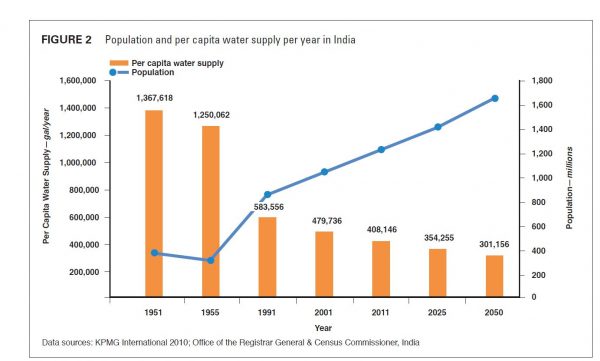Chennai suffered an acute water shortage during 2019. For 200 days there wasn’t a single drop of rain, and the city’s water resources ran out. Headlines of people lining up at water tankers, hand pumps spread globally, highlighting the problems faced by 7 million residents. This year (2020), Chennai received heavy rainfall which filled up the groundwater levels considerably. Things are good, but how long will this situation last ? Maintaining a sufficient supply of water during summer months will be the goal of the implementing bodies. Being able to tackle a dry spell during monsoons will be a challenge.
THE CHALLENGE OF WATER SCARCITY
163 million people in India do not have access to clean water near their homes and about 200,000 people due to inadequate supply of clean water. In Delhi, the Yamuna and some major river canals are the source of water. With many places getting only a few hours of water supply a day, the problem in Delhi is also an ongoing one. Owing to the rising pollution levels of Yamuna, the Central Pollution Control Board has directed Delhi Government to ensure sewage treatment before discharging it into the river to prevent frothing.

CAUSES OF WATER SHORTAGE
Pollution is a major cause of water scarcity in India. Other reasons include overpopulation, poor resource management and changing monsoon patterns. The excessive population has resulted in huge amounts of air and water pollution as well as deforestation. Chemicals used in farming, industrial and urban wastes and sewage are the primary sources of pollutants. Taking the average of India as a whole, about 80% of rainfall occurs in summer months. Due to poor management and proper techniques to use this water, there are floods. During summer months many places are strained because of falling water levels. When other sources are running dry, groundwater becomes the primary one to obtain water. However with overuse, this becomes problematic. More usage than recharge depletes the levels drastically and tube wells and borewells start running dry.
THE QUEST FOR A SOLUTION
It is clear that changes are required to combat this growing problem of water scarcity. The Wildlife Institute of India, Dehradun will be conducting the ecological survey of Six major India rivers; under the National River Conservation Plan.The rivers are- Mahanadi, Periyar, Godavari, Kaveri, Narmada and Barak .They will be assessing the flora and fauna, levels of pollution and impact of humans on ecological balance.
Better management of resources will go a long way in maintaining steady supply everywhere. In Tamil Nadu, the upcoming Cauvery-Gundar project will divert surplus water to South Vellar and Agniyar rivers. These rivers are facing a shortage of water for drinking and irrigation. In Nashik, a ‘Clean-up Godaveri’ project has been started by the Municipal Corporation. There will be steadily monitoring and removing solid waste from the river. Learning from this case, as well as from the Yamuna one, it is evident that special provisions need to be employed where rivers go through cities. With more and more development projects happening pan India, the situations with cities will only grow more challenging. Hence innovative and urgent policy changes are required.
Traditional irrigation techniques cause significant wastage of water from evaporations, drainage and excessive groundwater use. Educating farmers and making new techniques available such as drip and sprinkler irrigation can result in better management in the primary sector.
THE WAY FORWARD
Due to uneven patterns of rainfall, many places experience floods in monsoons and droughts in summer. With proper infrastructure to tap this rainwater, can help solve two issues together. Rainwater harvesting systems must be developed and put in place. Water reuse is also instrumental. The non-potable water from treated wastewater can be used for purposes like cleaning, industrial processing, irrigation etc.

With smart planning and innovation, we can use our water resources judiciously and achieve our developmental goals as well. Developing smart cities which ensure no human waste enters water bodies is important. As much of the water that can be cleaned and reused must be done, and any waste that is released must be treated. To ensure a bright future, we need to conserve this basic resource.

Be First to Comment